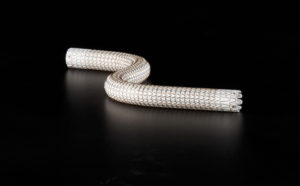 Gore announced on 28 June 2016 the publication of clinical study results from the Gore REVISE Clinical Study* in the Journal of Vascular Surgery detailing the success of the Gore Viabahn endoprosthesis with Heparin Bioactive Surface** in arteriovenous (AV) access graft outflow interventions.
Gore announced on 28 June 2016 the publication of clinical study results from the Gore REVISE Clinical Study* in the Journal of Vascular Surgery detailing the success of the Gore Viabahn endoprosthesis with Heparin Bioactive Surface** in arteriovenous (AV) access graft outflow interventions.
Overall, the device performed significantly better compared to percutaneous transluminal angioplasty (PTA) alone for treatment of challenging AV access cases in a real-world patient population, both in terms of primary patency and in number of interventions over the study period. Notably, the Gore REVISE clinical study is the first AV access stent graft study to include patients with thrombosed grafts and placement of the device across the elbow joint, further demonstrating the utility of the Gore Viabahn Endoprosthesis in this demanding clinical application.
“The data shown in the Gore REVISE Clinical Study manuscript makes a compelling argument for GORE VIABAHN Endoprosthesis use in those challenging cases.”
Key findings from the REVISE clinical study:
- The device delivered a 47% improvement in target lesion primary patency and a 48% improvement in circuit primary patency over PTA alone at six months.
- The device demonstrated a 50% increase over PTA in target lesion primary patency at six months when treating thrombosed AV access circuits.
- When placed across the elbow, the Gore Viabahn endoprosthesis delivered 72% target lesion primary patency at six months and 83% access secondary patency at 24 months (n=22).
- The Gore REVISE clinical study also showed median time to target lesion reintervention or graft abandonment with Gore Viabahn Endoprosthesis was approximately twice that achieved with PTA (203 versus 108 days).
- Placement of Gore Viabahn endoprosthesis led to 27% fewer interventions both at the target lesion and in the dialysis access circuit over a 24-month period compared to PTA.
According to the United States Renal Data System, there are over 700,000 patients with end-stage renal disease (ESRD) and nearly 90 percent of those patients are receiving hemodialysis. Arteriovenous grafts (AVG) are often used to create dialysis circuits for patients. Failing dialysis circuits often result in the placement of infection-prone central venous catheters (CVCs) while a new dialysis access circuit is surgically created and matured. Balloon angioplasty is a common fix in the event of a failing circuit, but many patients are unresponsive to the procedure, which has left a gap in treatment capabilities for difficult anatomies. The Gore REVISE clinical study demonstrated that placement of a stent-graft leads to better patient outcomes with reduced interventions, a positive finding for all stakeholders involved in the patient’s care.
“Patients with failing dialysis circuits that are unresponsive to balloon angioplasty are a real problem for physicians. Historically, angioplasty has been a popular treatment option, but our study found its six-month primary patency rates to be well below the ‘reasonable goal’ of 50 percent stated by the 2006 K/DOQI Guidelines for Vascular Access,” said Thomas Vesely, interventional radiologist from the Vascular Access Services in St Louis, USA, and the primary author of the JVS paper. “The data shown in the Gore REVISE clinical study manuscript make a compelling argument for Gore Viabahn endoprosthesis use in those challenging cases.”
In 2013, the FDA granted indication for the Gore Viabahn endoprosthesis to maintain and salvage failing dialysis access circuits. The Gore device is the lowest profile, most flexible, self-expanding, small-diameter endoprosthesis available and the only stent or stent graft to receive approval for the superficial femoral artery (SFA), in-stent restenosis of bare metal stents in the SFA, iliac artery, and AV access. It is constructed with a durable, reinforced, biocompatible, expanded polytetrafluorethylene (ePTFE) liner and attached to an external nitinol stent structure. The GORE VIABAHN Endoprosthesis also features Gore’s CBAS Heparin Surface, the proven, lasting heparin bonding technology designed to resist thrombus formation.
“The Gore REVISE clinical study was the clinical support used to gain the US on-label indication for Gore Viabahn endoprosthesis in AV access,” said Ray Swinney, Business Unit Leader for the Gore Peripheral Interventional Business Unit. “By expanding indications to include AV access, Gore Viabahn endoprosthesis continues to show how physicians can depend on the device for complete coverage in complex cases.”
For more information about the Gore REVISE study and the success of the Gore Viabahn endoprosthesis in AV access graft outflow interventions, the Journal of Vascular Surgery article can be viewed online at http://www.jvascsurg.org/article/S0741-5214(16)30175-6/fulltext.
*Vesely T, DaVanzo W, Behrend T, Dwyer A, Aruny J. Balloon angioplasty versus Viabahn stent graft for treatment of failing or thrombosed prosthetic hemodialysis grafts. Journal of Vascular Surgery. In press.












